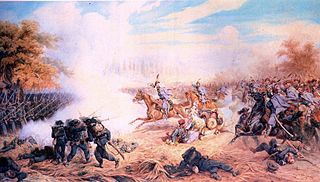Third Italian War of Independence
| Third Italian War of Independence | |||||||||
|---|---|---|---|---|---|---|---|---|---|
| Part of Austro-Prussian War, Wars of Italian Unification | |||||||||
 Austrian Uhlans charge Italian Bersaglieri during the Battle of Custoza. Painting by Juliusz Kossak |
|||||||||
|
|||||||||
| Belligerents | |||||||||
|
|
|
||||||||
| Commanders and leaders | |||||||||
| Strength | |||||||||
|
Mincio Army
Total: 120,000 men Po Army
Total: 80,000 men Garibaldi's forces
Total:20,000 men Total: 220,000 men |
South Army
|
||||||||
| Casualties and losses | |||||||||
| c. 9,500 casualties | 8,470 casualties | ||||||||
Mincio Army
Total: 120,000 men
Po Army
Total: 80,000 men
Garibaldi's forces
Total:20,000 men
South Army
The Third Italian War of Independence (Italian: Terza Guerra d'Indipendenza Italiana) was a conflict which paralleled the Austro-Prussian War, and was fought between the Kingdom of Italy and the Austrian Empire.
Victor Emmanuel II of Savoy had been crowned King of Italy on March 17, 1861, but did not control Venetia and the much reduced Papal States. The situation of the Irredente (a later Italian term for part of the country under foreign domination, literally meaning un-redeemed) was an unceasing source of tension in the domestic politics of the newly created Kingdom, as well as being a cornerstone of its foreign policy.
The first attempt to seize Rome was orchestrated by Giuseppe Garibaldi in 1862. Confident in the King's neutrality, he set sail from Genoa to Palermo. Collecting 1,200 volunteers, he sailed from Catania and landed at Melito, in Calabria, on August 24 to reach Mount Aspromonte, with the intention to travel northwards up the peninsula to Rome. The Piedmontese General Enrico Cialdini, however, sent a division under Colonel Pallavicino to stop the volunteer army. Garibaldi himself was wounded in the ensuing battle, and taken prisoner along with his men.
The increasing discord between Austria and Prussia over the German Question turned into open war in 1866, offering Italy an occasion to capture Venetia. On April 8, 1866 the Italian government signed a military alliance with Prussia, through the mediation of Emperor Napoleon III of France. Italian armies, led by General Alfonso Ferrero La Marmora, were to engage the Austrians on the southern front. Simultaneously, taking advantage of their perceived naval superiority, the Italians planned to threaten the Dalmatian coast and seize Trieste.
...
Wikipedia
